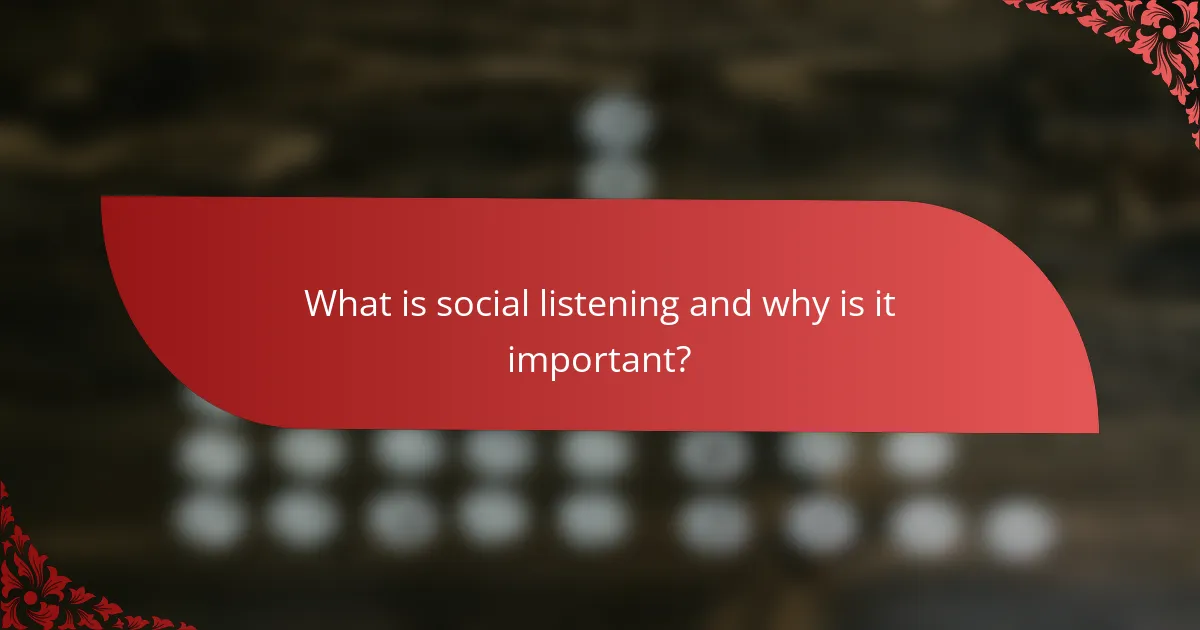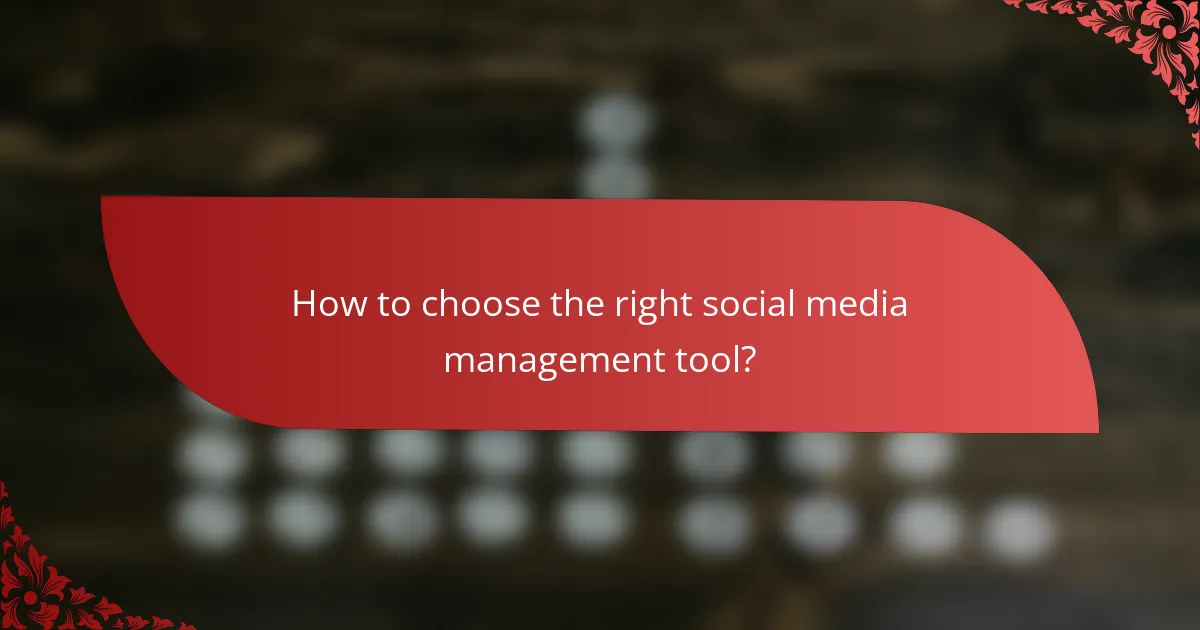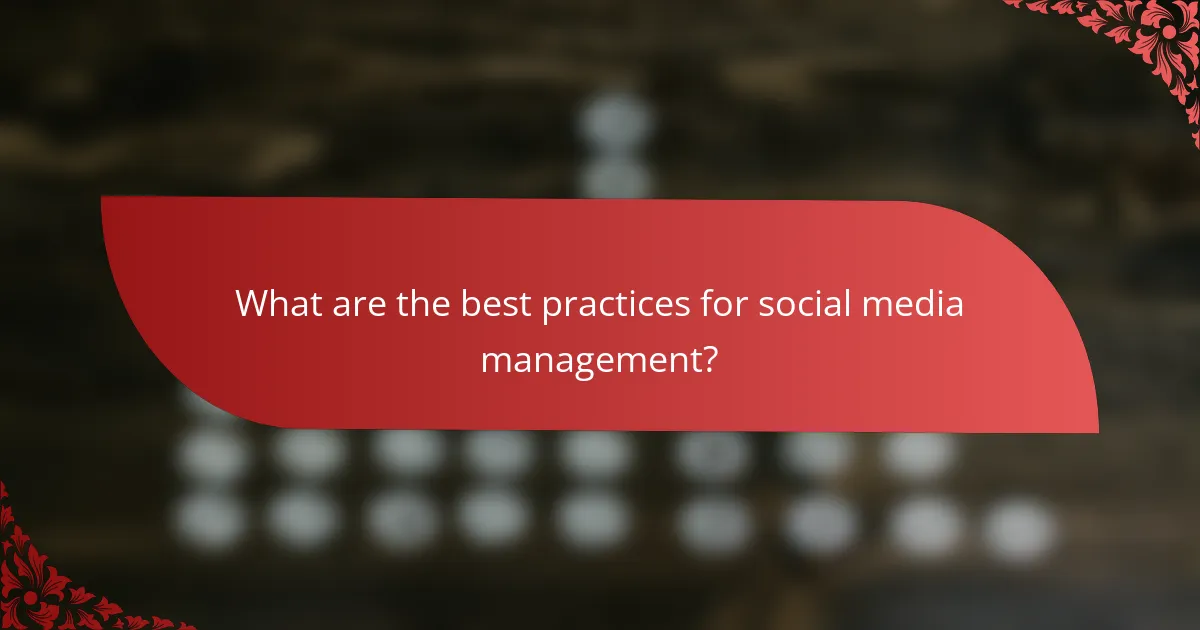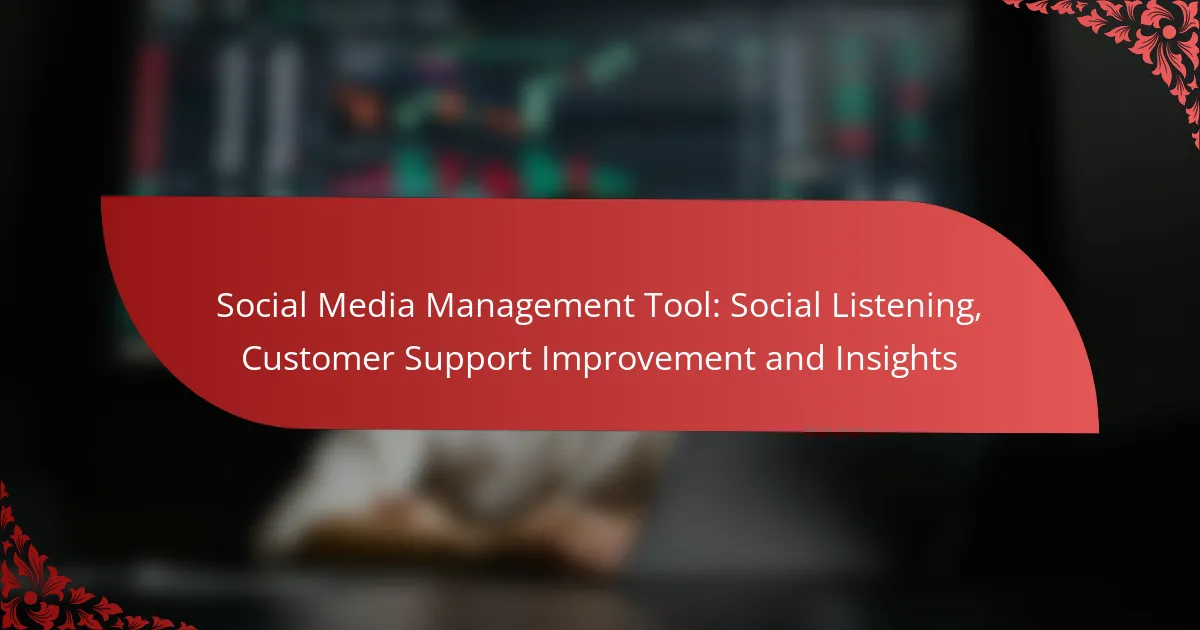Social media management tools play a vital role in enhancing customer support by facilitating efficient communication and providing insights into customer preferences. By leveraging social listening, businesses can monitor online conversations to engage with their audience effectively and manage their reputation. These tools not only streamline responses but also offer analytics that help organizations understand audience behavior and improve overall engagement.

How can social media management tools enhance customer support?
Social media management tools can significantly enhance customer support by streamlining communication, improving response times, and providing valuable insights into customer needs. These tools enable businesses to monitor interactions, respond promptly, and analyze feedback effectively.
Real-time response tracking
Real-time response tracking allows businesses to monitor customer inquiries as they happen, ensuring timely engagement. This feature helps support teams identify urgent issues and prioritize responses based on customer sentiment and urgency.
For example, a company can set alerts for mentions or direct messages, allowing them to respond within minutes rather than hours. This immediacy can lead to higher customer satisfaction and loyalty.
Integration with CRM systems
Integrating social media management tools with Customer Relationship Management (CRM) systems centralizes customer interactions and data. This integration allows support teams to access customer histories and preferences, leading to more personalized interactions.
For instance, when a customer reaches out via social media, the support agent can see their previous interactions and tailor responses accordingly, improving the overall customer experience.
Sentiment analysis for customer feedback
Sentiment analysis tools evaluate customer feedback across social media platforms to gauge public perception of a brand. By analyzing comments, reviews, and messages, businesses can identify trends in customer satisfaction and areas needing improvement.
For example, if sentiment analysis reveals a spike in negative feedback about a product, the company can address the issue proactively, potentially mitigating damage to their reputation.
Automated customer interactions
Automated customer interactions, such as chatbots, can handle common inquiries and provide instant responses. This automation frees up human agents to focus on more complex issues while ensuring that customers receive prompt assistance.
Many businesses implement chatbots to answer FAQs or guide users through troubleshooting steps, which can significantly reduce response times and improve efficiency.
Case studies from Hootsuite
Hootsuite has documented several case studies showcasing how businesses have improved their customer support through social media management tools. For example, a retail company increased its response rate by over 50% after implementing Hootsuite’s tools to monitor social media interactions.
Another case study highlighted a service provider that reduced customer complaint resolution time by utilizing automated responses for common issues, leading to a notable increase in customer satisfaction ratings.

What is social listening and why is it important?
Social listening is the process of monitoring online conversations to understand what customers are saying about a brand, product, or industry. It is crucial for brands to engage with their audience, manage their reputation, and gain insights that can drive business decisions.
Definition of social listening
Social listening involves tracking social media platforms, blogs, forums, and other online channels to gather insights about consumer opinions and trends. This practice goes beyond merely monitoring brand mentions; it includes analyzing sentiments, identifying key influencers, and understanding the broader context of discussions.
By utilizing social listening, companies can capture real-time feedback and adapt their strategies accordingly, ensuring they remain relevant and responsive to customer needs.
Benefits for brand reputation
Effective social listening can significantly enhance a brand’s reputation by allowing businesses to address customer concerns promptly. When brands respond to negative feedback or engage positively with customers, they demonstrate that they value consumer input, which can foster loyalty and trust.
Moreover, understanding public sentiment helps brands identify potential crises before they escalate. By proactively managing their online presence, companies can maintain a positive image and build stronger relationships with their audience.
Tools for effective social listening
Several tools can facilitate social listening, each offering unique features to help brands monitor their online presence. Popular options include Hootsuite, Brandwatch, and Sprout Social, which provide analytics, sentiment analysis, and engagement tracking.
When selecting a tool, consider factors such as ease of use, integration capabilities, and pricing. Many platforms offer tiered pricing models, allowing businesses of various sizes to find a solution that fits their budget and needs.

Which social media management tools offer insights?
Several social media management tools provide valuable insights to help businesses understand their audience and improve engagement. Tools like Sprout Social, Buffer, and Agorapulse offer analytics features that track performance metrics, audience behavior, and content effectiveness.
Sprout Social analytics features
Sprout Social offers robust analytics features that allow users to track engagement metrics, audience demographics, and post performance. Its reporting tools provide visual representations of data, making it easier to identify trends and adjust strategies accordingly.
Users can create customized reports to focus on specific metrics, such as engagement rates or follower growth, which can be particularly useful for tailoring content to audience preferences. Additionally, Sprout Social’s social listening capabilities help identify brand sentiment and emerging trends in real-time.
Buffer reporting capabilities
Buffer provides straightforward reporting capabilities that help users analyze their social media performance over time. Its dashboard includes key metrics such as reach, clicks, and engagement, allowing for quick assessments of what content resonates with the audience.
One notable feature is the ability to compare performance across different platforms, which helps in optimizing content for each specific channel. Buffer also offers scheduling insights, enabling users to determine the best times to post based on audience activity.
Agorapulse insights dashboard
Agorapulse features an insights dashboard that aggregates data from various social media platforms, providing a comprehensive view of performance metrics. Users can track engagement, response times, and audience growth, which are essential for evaluating social media strategies.
The platform also includes competitor analysis tools, allowing users to benchmark their performance against industry peers. This can help identify areas for improvement and inform future content strategies. Agorapulse’s user-friendly interface makes it easy to navigate through insights and generate reports for stakeholders.

How to choose the right social media management tool?
Choosing the right social media management tool involves evaluating your specific needs, such as social listening capabilities, customer support improvement features, and insights generation. Focus on tools that align with your business goals and budget while offering the functionalities that matter most to your team.
Key features to consider
When selecting a social media management tool, prioritize features like social listening, which allows you to monitor brand mentions and industry trends. Additionally, look for customer support functionalities that enable quick responses to inquiries and issues.
Insights generation is another crucial feature; it provides analytics on engagement, audience demographics, and campaign performance. Tools that offer customizable dashboards can help visualize this data effectively.
Pricing models comparison
Social media management tools typically offer various pricing models, including subscription-based plans, pay-as-you-go options, or tiered pricing based on features. Subscription plans often range from around $10 to several hundred dollars per month, depending on the number of users and features included.
Consider whether you need a basic plan for a small team or a more comprehensive package for larger organizations. Some tools may also offer free trials, allowing you to test their features before committing financially.
User reviews and ratings
User reviews and ratings provide valuable insights into the effectiveness and usability of social media management tools. Check platforms like G2 or Capterra for aggregated ratings and detailed user feedback.
Look for common themes in reviews, such as ease of use, customer support quality, and the reliability of features. High ratings in these areas often indicate a tool that can meet your social media management needs effectively.

What are the best practices for social media management?
Effective social media management involves strategic planning, consistent engagement, and insightful analysis. Best practices include content scheduling, active audience interaction, and leveraging analytics to refine strategies.
Content scheduling strategies
Content scheduling is crucial for maintaining a consistent online presence. Utilize tools that allow you to plan posts in advance, ensuring that your content reaches your audience at optimal times. Aim for a posting frequency that keeps your brand visible without overwhelming followers, typically ranging from a few times a week to daily, depending on the platform.
Consider using a content calendar to organize themes, campaigns, and key dates. This helps in aligning your posts with relevant events or promotions, enhancing engagement. For example, if you’re a retailer, schedule posts around holidays or sales events to maximize visibility and interaction.
Engagement techniques
Engagement techniques are essential for building a loyal community. Responding promptly to comments and messages fosters a sense of connection and shows that you value your audience’s input. Aim to reply within a few hours to maintain a positive interaction experience.
Incorporate interactive content such as polls, questions, and live Q&A sessions to encourage participation. These methods not only boost engagement but also provide valuable insights into your audience’s preferences. For instance, a quick poll about product preferences can guide future content and offerings.
